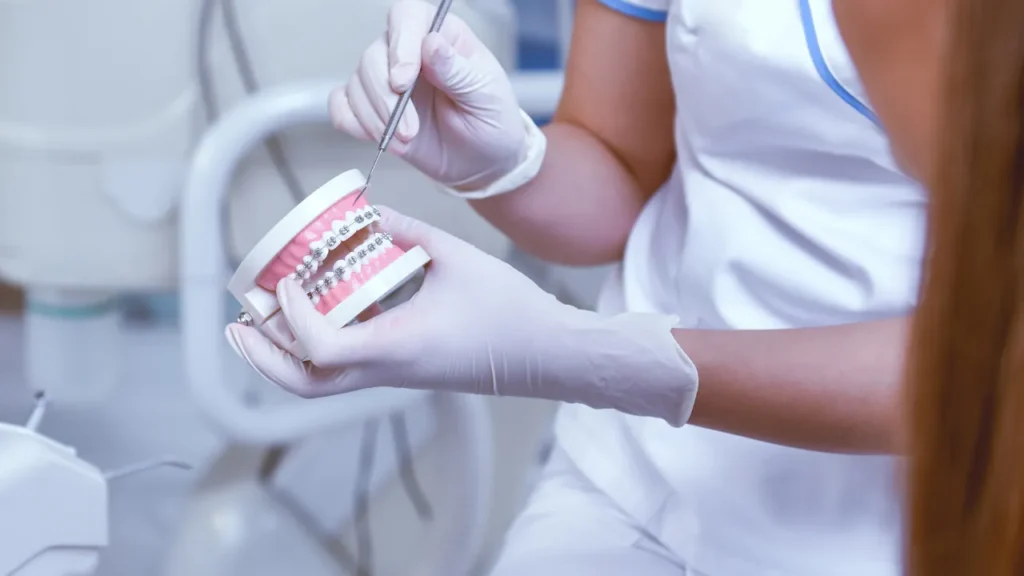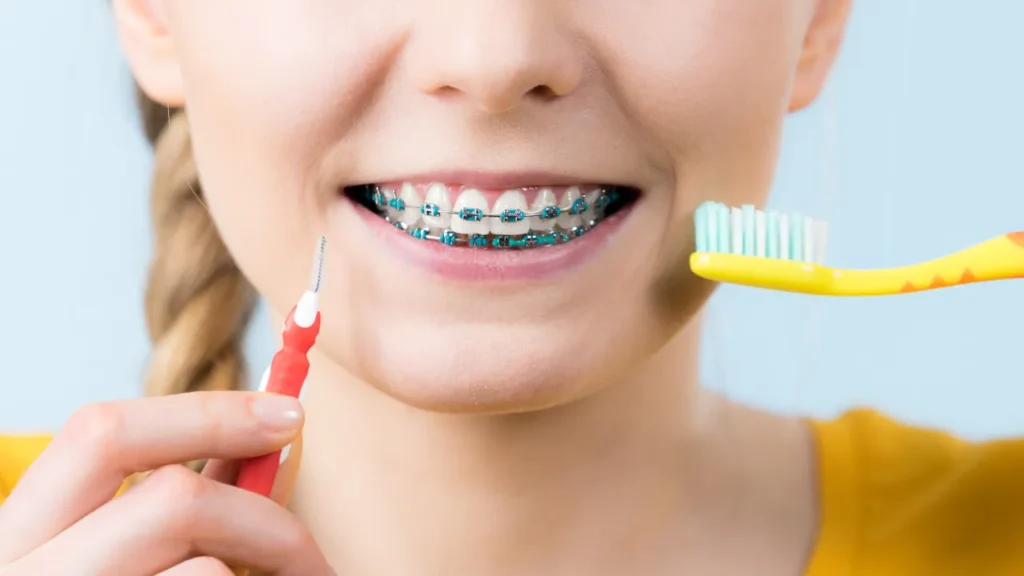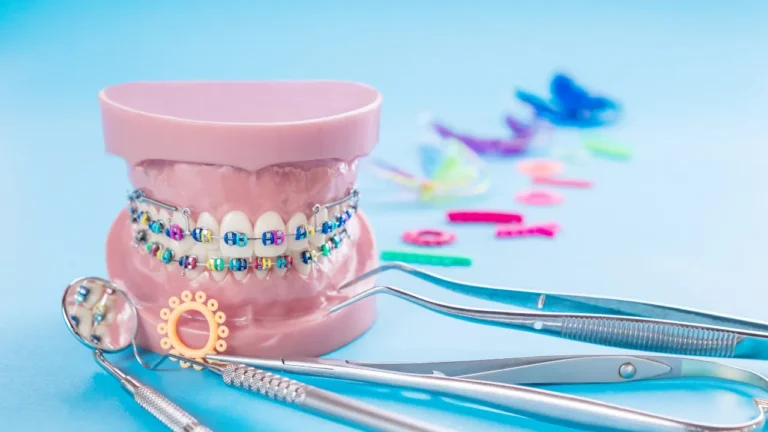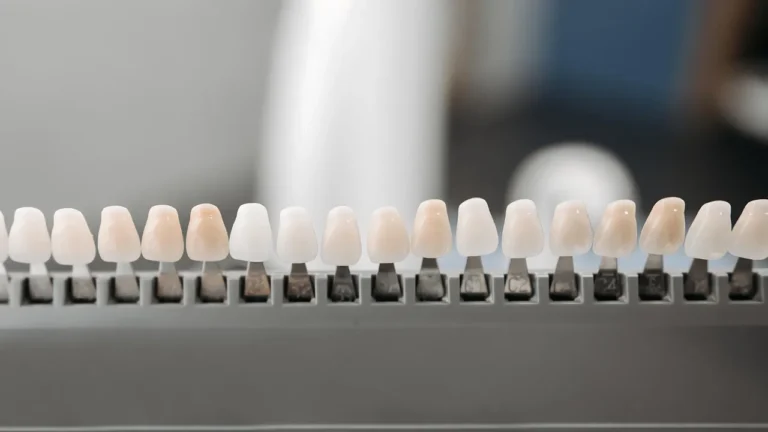Braces have long been a popular and effective solution for correcting misaligned teeth and achieving a healthy, beautiful smile.
Whether you’re considering braces for yourself or your child, understanding the process, types of braces available, and what to expect can help you make informed decisions.
In this guide, we’ll cover everything you need to know about braces, from how they work to the benefits they offer.
What Are Braces and How Do They Work?
Braces are orthodontic devices designed to straighten teeth, correct bite issues, and improve overall dental health.
They work by applying continuous pressure over time to gradually move teeth into their desired positions. Braces consist of several components:
- Brackets: Small metal or ceramic pieces attached to the front of each tooth.
- Archwires: Thin metal wires that connect the brackets and guide the teeth into place.
- Bands: Elastic bands that hold the archwire in place and help move the teeth.
- Ligatures: Small rubber bands used to secure the archwire to the brackets.
By adjusting the tension in the wires and bands, your orthodontist can control the movement of your teeth, guiding them into a straighter, more functional alignment.
Types of Braces Available
When it comes to braces, there are several options to choose from, each with its own advantages:
1. Traditional Metal Braces
Overview: The most common type of braces, made from high-quality stainless steel.
Advantages: Durable, effective for complex cases, and typically the most affordable option.
Considerations: Visible on the teeth, may cause slight discomfort initially.
2. Ceramic Braces
Overview: Similar to metal braces but made from tooth-colored ceramic materials, making them less noticeable.
Advantages: Aesthetic appeal, effective for a wide range of orthodontic issues.
Considerations: Slightly more expensive than metal braces, brackets can be more prone to staining.
3. Lingual Braces
Overview: Braces that are placed on the back (lingual side) of the teeth, making them invisible from the front.
Advantages: Completely hidden from view, effective for most cases.
Considerations: More difficult to clean, may take longer to adjust to, and can be more expensive.
4. Clear Aligners (Invisalign)
Overview: A series of custom-made, clear plastic trays that gradually shift teeth into place.
Advantages: Virtually invisible, removable for eating and cleaning, no food restrictions.
Considerations: Best for mild to moderate cases, requires strict compliance with wearing the aligners 20-22 hours a day, generally more expensive.

The Braces Process: What to Expect
Getting braces involves several steps, and knowing what to expect can make the process smoother:
1. Initial Consultation
Your orthodontic journey begins with a consultation, where your orthodontist will assess your teeth, bite, and jaw alignment. This includes taking X-rays, photos, and impressions to create a treatment plan tailored to your needs.
2. Fitting the Braces
Once the treatment plan is in place, your orthodontist will attach the braces to your teeth. This process typically takes about 1-2 hours and is painless. You may feel some pressure as the brackets are bonded to your teeth and the archwire is placed.
3. Regular Adjustments
Throughout your treatment, you’ll visit your orthodontist every 4-8 weeks for adjustments. During these visits, the orthodontist will tighten the wires, change the elastics, and monitor your progress. These adjustments may cause some discomfort, but it usually subsides within a few days.
4. Removing the Braces
The day you get your braces removed is a major milestone! After removing the braces, your orthodontist will clean your teeth and take final impressions to create a retainer. The retainer is crucial for maintaining the new position of your teeth.
5. Retention Phase
Wearing your retainer as instructed by your orthodontist is essential to prevent your teeth from shifting back to their original positions. Depending on your case, you may need to wear the retainer full-time initially, then transition to wearing it only at night.
Benefits of Getting Braces
Braces offer numerous benefits beyond just straightening your teeth:
- Improved Oral Health: Straighter teeth are easier to clean, reducing the risk of cavities, gum disease, and other oral health issues.
- Enhanced Appearance: A straight smile boosts your confidence and can improve your overall appearance.
- Better Bite Function: Braces correct bite issues, making it easier to chew and speak properly.
- Preventing Future Problems: Correcting alignment issues now can prevent more serious dental problems later in life.

Caring for Your Braces
Proper care is essential to ensure your braces work effectively and your treatment stays on track:
- Brushing and Flossing: Brush your teeth at least twice a day and floss daily, taking extra care to clean around the brackets and wires.
- Avoid Certain Foods: Stay away from sticky, hard, or crunchy foods that can damage your braces, such as gum, popcorn, and hard candy.
- Wear a Mouthguard: If you play sports, wear a mouthguard to protect your braces and teeth from injury.
- Attend All Appointments: Regular visits to your orthodontist are crucial for keeping your treatment on schedule and addressing any issues that arise.
Conclusion
Braces are a valuable investment in your oral health and overall appearance. Whether you opt for traditional metal braces, clear aligners, or another option, the journey to a straighter smile is well worth it. By understanding the types of braces available, the treatment process, and the benefits, you can make an informed decision and enjoy the many rewards of a beautifully aligned smile.
Call to Action:
Ready to achieve the smile you’ve always wanted? Schedule a consultation with our orthodontic experts today and take the first step towards a healthier, more confident you.
FAQS
How much do braces cost?
The cost of braces can vary depending on the type of braces, the complexity of your case, and the length of your treatment. On average, traditional metal braces cost between R25,000 and R50,000 in South Africa. Ceramic braces, lingual braces, and clear aligners like Invisalign may cost more due to their materials and customization.
How long will I need to wear braces?
The duration of your treatment depends on the severity of your case and the type of braces you choose. Most people wear braces for 18 to 24 months, but some cases may require longer treatment. Your orthodontist will provide an estimated timeline during your initial consultation.
Do braces hurt?
Braces may cause some discomfort, especially after adjustments, but they should not be painful. The pressure from the wires and bands can make your teeth and gums feel sore for a few days, but over-the-counter pain relief and a soft food diet can help ease this discomfort.
Can adults get braces?
Absolutely! Braces are not just for children and teenagers. Many adults choose to get braces to correct misaligned teeth and improve their smile. There are several discreet options available, such as ceramic braces and clear aligners, which are popular among adults.
How do I clean my teeth with braces?
Proper oral hygiene is crucial when you have braces. Brush your teeth at least twice a day with a soft-bristled toothbrush, paying close attention to the areas around your brackets and wires. Floss daily using a floss threader or orthodontic floss to clean between your teeth and under the wires. Your orthodontist may also recommend an interdental brush or water flosser for additional cleaning.
What foods should I avoid with braces?
While wearing braces, you should avoid foods that are sticky, hard, or crunchy, as they can damage your brackets and wires. Some foods to avoid include chewing gum, caramel, popcorn, nuts, and hard candy. It’s also best to cut fruits and vegetables into small pieces to avoid putting too much pressure on your braces.
Can I play sports with braces?
Yes, you can still play sports while wearing braces, but it’s important to protect your teeth. Wear a mouthguard to shield your braces and teeth from injury during contact sports. Your orthodontist can provide a custom-fitted mouthguard for the best protection.
What happens if a bracket or wire breaks?
If a bracket or wire breaks, contact your orthodontist as soon as possible to schedule a repair appointment. In the meantime, you can use orthodontic wax to cover any sharp edges and prevent irritation to your mouth. Avoid trying to fix the problem yourself, as this can cause further damage.
How often will I need to visit the orthodontist during treatment?
You’ll need to visit your orthodontist every 4 to 8 weeks for adjustments and to monitor your progress. These regular check-ups are essential to ensure your treatment stays on track and to make any necessary adjustments to your braces.
Will I need to wear a retainer after my braces are removed?
Yes, wearing a retainer after your braces are removed is crucial to maintaining your new smile. A retainer helps keep your teeth in their new positions and prevents them from shifting back. Your orthodontist will advise you on how long you’ll need to wear your retainer and whether it should be worn full-time or just at night.









